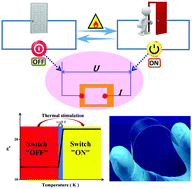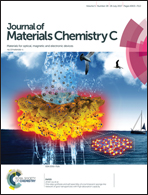Fast and slow integrated single-molecule dual dielectric switch based on a crystal/flexible thin film†
Abstract
Smart plastic crystals/films based on organic–inorganic hybrid materials are rarely reported in the form of highly-integrated intelligent controllable dielectric switches (switching between ON/OFF or “1”/“0”), especially tunable switches with dual ON/OFF effects that are integrated in a single molecule. Herein, two superior plastic crystals, [C6H15ClNO]2[MCl4] (M = Cd for 1, Mn for 2), which are able to exhibit tunable and dual dielectric switching characteristics between three stages triggered by temperature (LTP, RTP and HTP) in a single molecule, were successfully synthesized and prepared as ultraflexible and monodirectional thin films. Such excellent features lay the foundation for their applications in temperature-adjustable multifunctional single-molecule sensors and memory devices. Specifically, through control of the operating temperature, the fast dielectric switch (high temperature phase transition stage) and the slow/delayed dielectric switch (low temperature phase transition stage) can be integrated in a single molecular device cell. As well as the superior stability/fatigue resistance of the crystals, the facile/environmentally-friendly fabrication of the thin films makes 1 and 2 excellent candidates for single-molecule intelligent devices and highly-integrated dual-switching devices in the modern electronic information industry.

- This article is part of the themed collection: 2017 Journal of Materials Chemistry C HOT Papers


 Please wait while we load your content...
Please wait while we load your content...